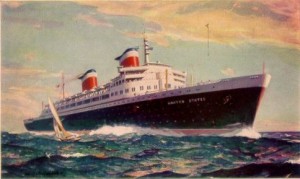Unfortunately, the opportunities for sailing to Europe are few. Cunard Line, for instance, offers trips around the world. But going to Southampton, England, on the Queen Mary 2 will cost travelers six days and nights, and at least $1,000. No matter how fast or free the wireless service on board is, taking that much time and spending that much money on a one-way trip to England is difficult to justify.
But maybe not if you are H. F. (Gerry) Lenfest, a philanthropist in suburban Philadelphia who not only can afford to travel on ocean liners but has the means to purchase them. This summer Lenfest gave the SS United States Conservancy up to $5.8 million to purchase the nonprofit's namesake. This gift will allow the Conservancy, established in 1992, to keep the ship at its Delaware River port in Philadelphia while the directors decide the next phase in the liner’s relatively short existence.
According to a recent story in the Weekly Press, a local Philadelphia newspaper, the SS United States was remarkable achievement during the Cold War. It was designed as both a luxury passenger liner that could accommodate 3,500 passengers and that, if need be, could double as a Navy-sponsored troop transport, carrying 15,000 soldiers more than 10,000 miles without refueling. Not only is she big but she is (or was) fast. Her maiden voyage from New York to England in July 1952, took 3 days, 10 hours and 40 minutes, with an average speed of 35 knots. That was a record and shaved 10 hours off the Queen Mary’s fastest time. Dan McSweeney, the conservancy’s director, told the Weekly Press’ reporter boastfully that the United States could go as fast backwards as today’s cruise ships go forward (20 knots); the United States could go forward as fast as 42 knots.
The SS United States’s last voyage occurred in the fall of 1969 and the timing was not coincidental. According to the Weekly Press, “Suddenly, lifestyle in America was all about speed. By 1958, a jet could make it to Europe in seven hours instead of several days, and by 1970, when Alvin Toffler wrote Future Shock, foretelling the fast-forward of the next 50 years, the speed of the jet aircraft had unraveled the appeal of the luxury liner, and too soon, the SS United States was running in the red, at enormous losses.”
After 1969 the SS United States passed through different hands and different ports, none of them necessarily soft or kind. Owners gutted her elaborate appointments either for profit or to pay down loans. She arrived in Philadelphia in 1996 and been waiting ever since for the right owner and use. For Walter Cronkite, the ship’s neglect “a crime against shipbuilding.”
So, where the market for ocean-liner travel has failed, philanthropy has stepped in. The most likely option is for the ship to be used as a waterfront tourist attraction, either in Philadelphia or New York City, with a museum, restaurants, retail shops, and other forms of entertainment. Some at the Conservancy hope that she might still be retooled for sailing on the high sea. Whatever her fate, Gerry Lenfest, like so many philanthropists, has saved a legendary ship from a bygone era and in so doing holds out hope for those of us on airline budgets who long for more elegance and less speed in modern travel.




1 thought on “When markets fail”
Comments are closed.